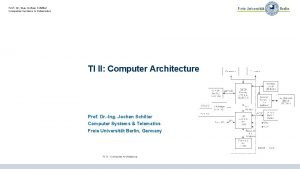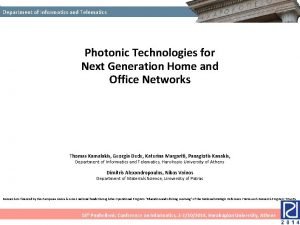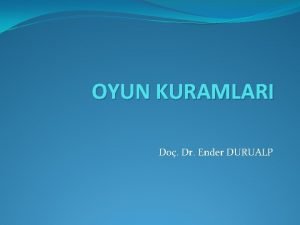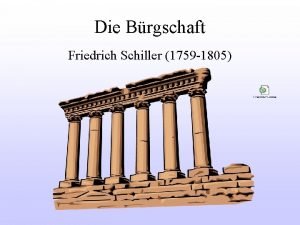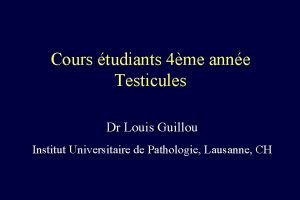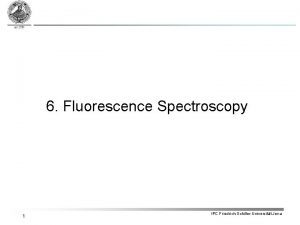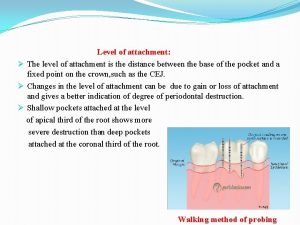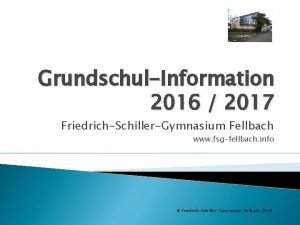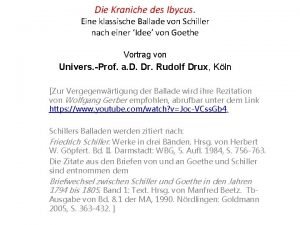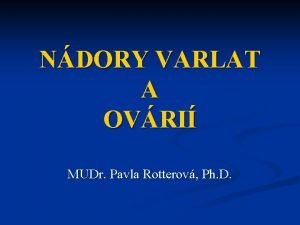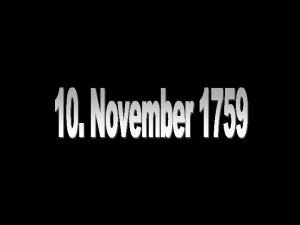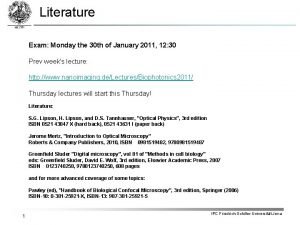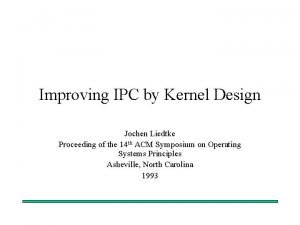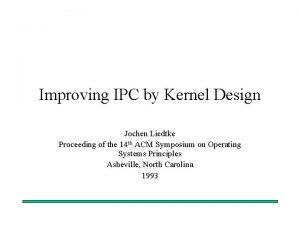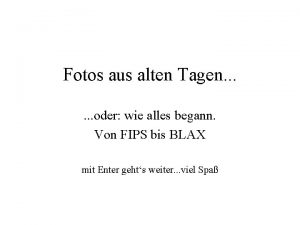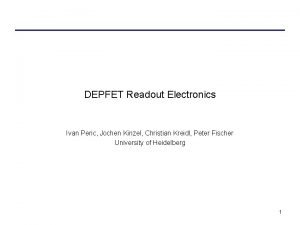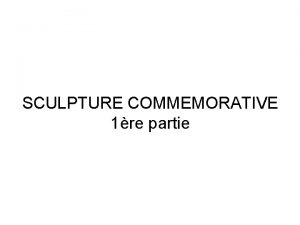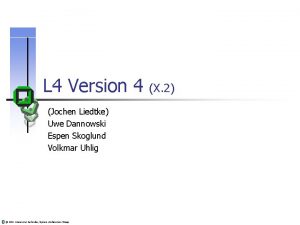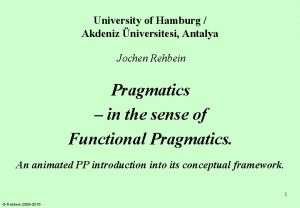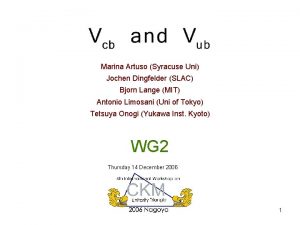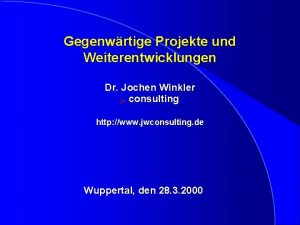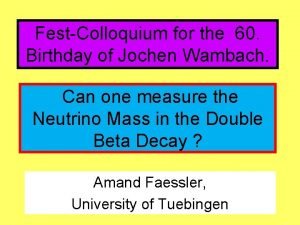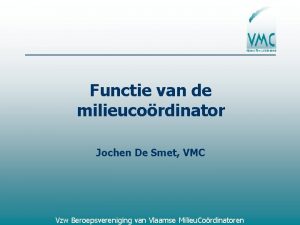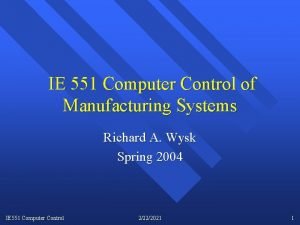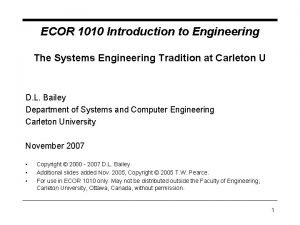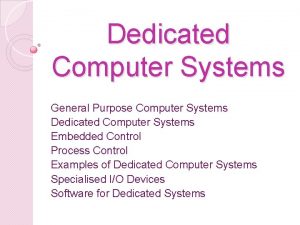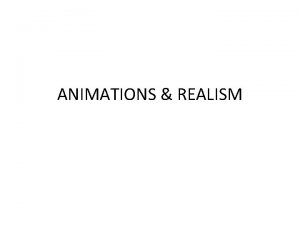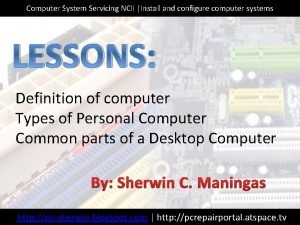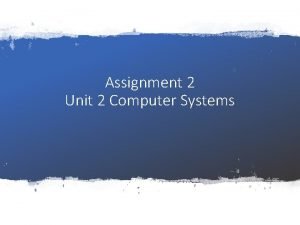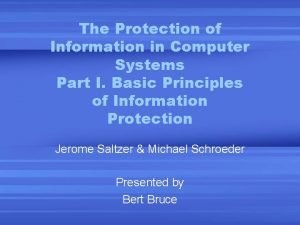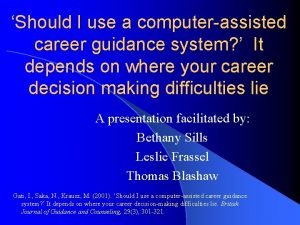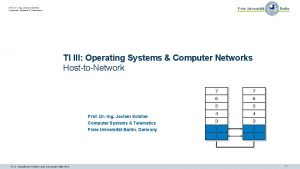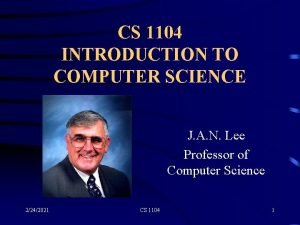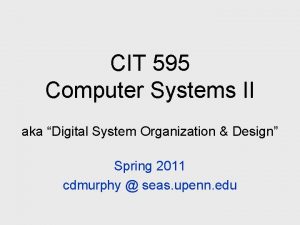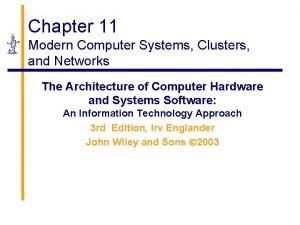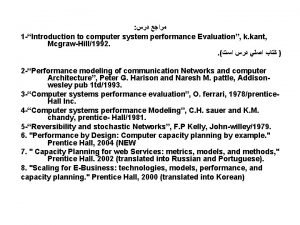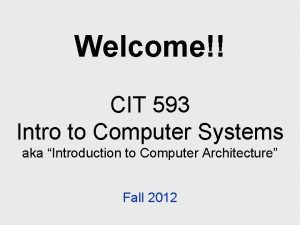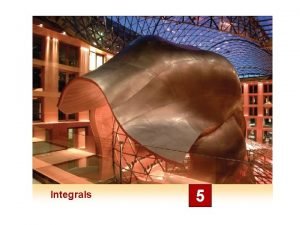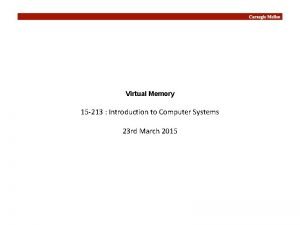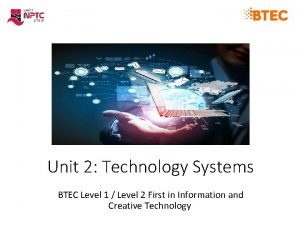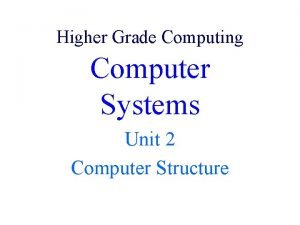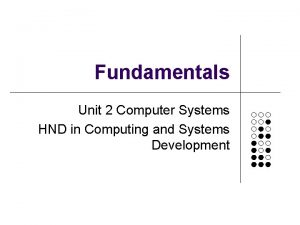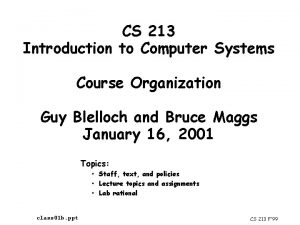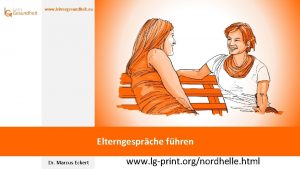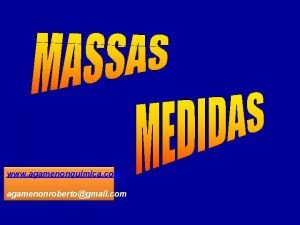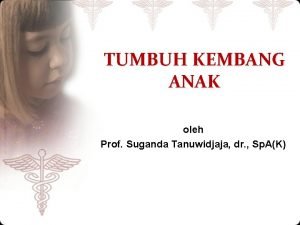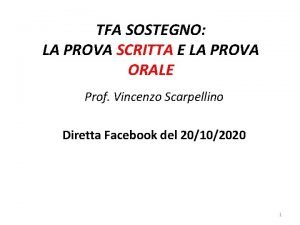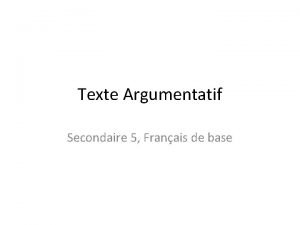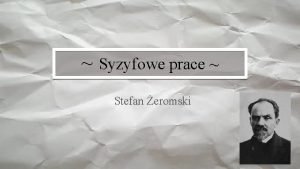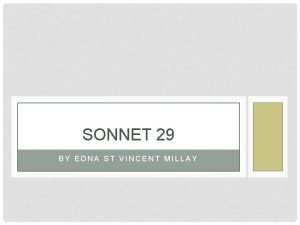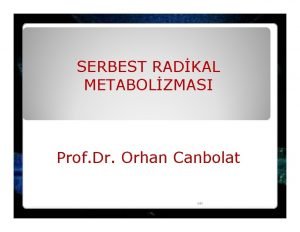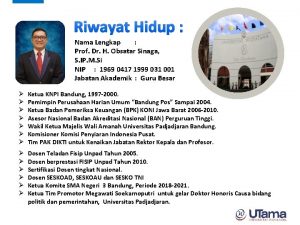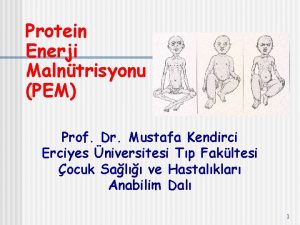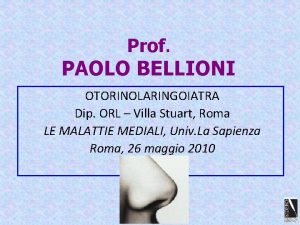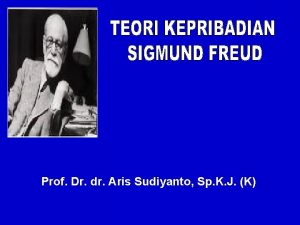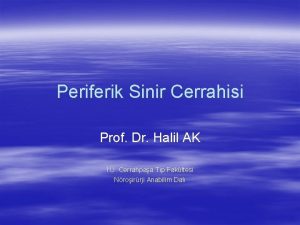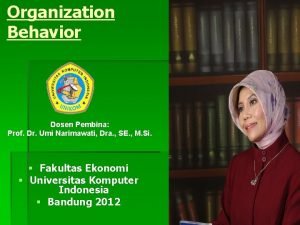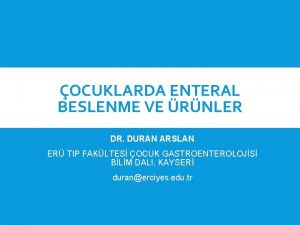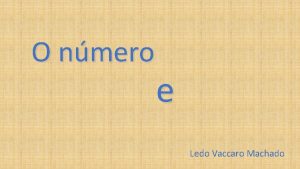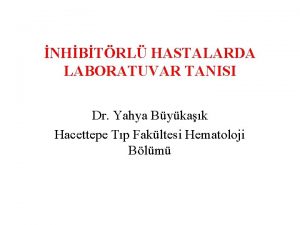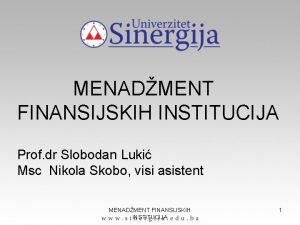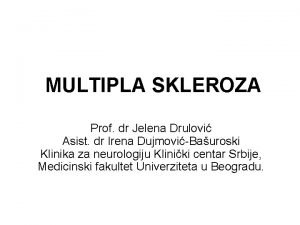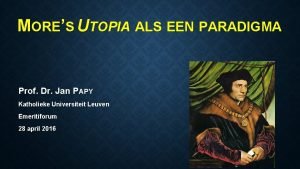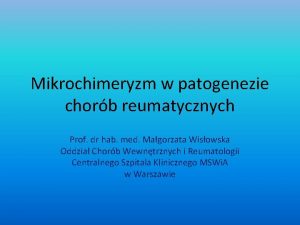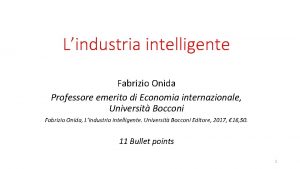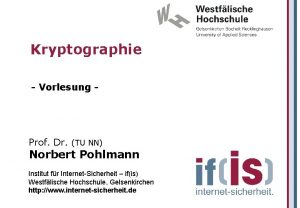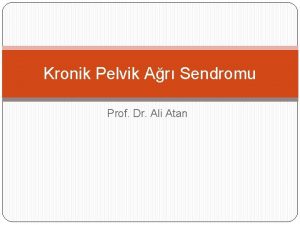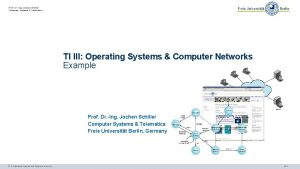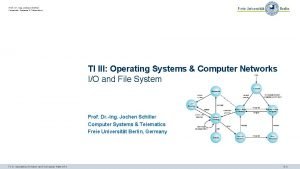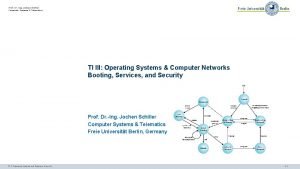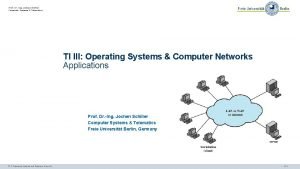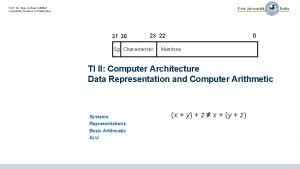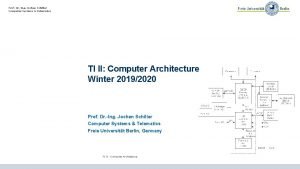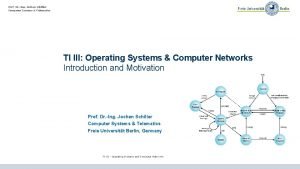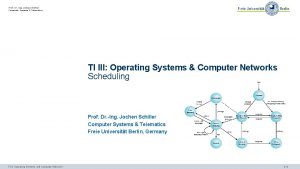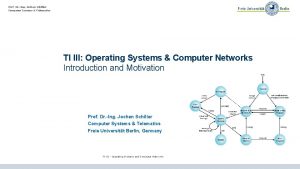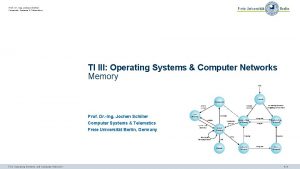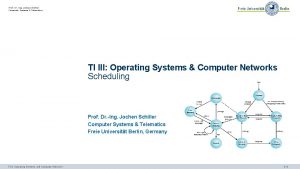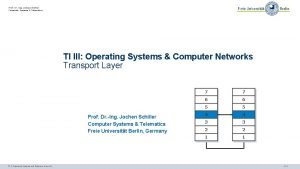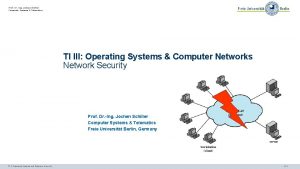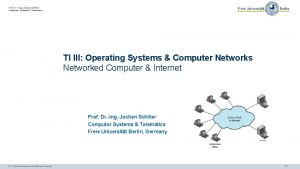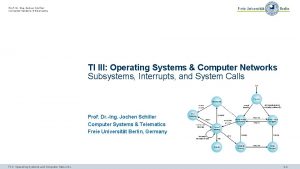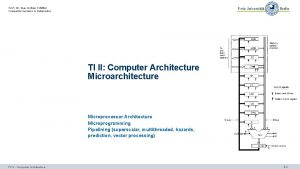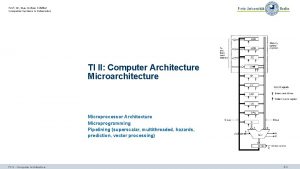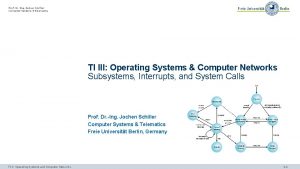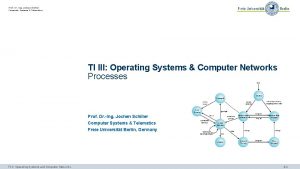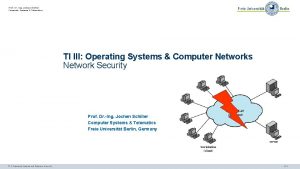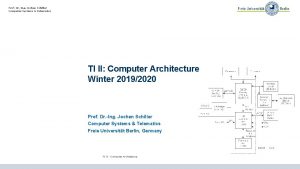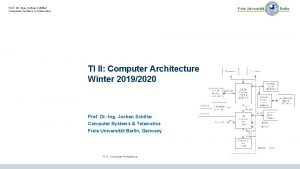Prof Dr Ing Jochen Schiller Computer Systems Telematics












































































































- Slides: 108

Prof. Dr. -Ing. Jochen Schiller Computer Systems & Telematics 31 30 Sg 23 22 Characteristic/ Exponent 0 Significand/Mantissa/Fraction TI II: Computer Architecture Data Representation and Computer Arithmetic (x + y) + z ≠ x + (y + z) Systems Representations Basic Arithmetic ALU 1 + ε = 1, ε > 0 x + y < x, y > 0

Content 1. Introduction - Single Processor Systems Historical overview Six-level computer architecture 2. Data representation and Computer arithmetic - Data and number representation Basic arithmetic 3. Microarchitecture - 4. Instruction Set Architecture - CISC vs. RISC Data types, Addressing, Instructions Assembler 5. Memories - Hierarchy, Types Physical & Virtual Memory Segmentation & Paging Caches Microprocessor architecture Microprogramming Pipelining TI II - Computer Architecture 2. 2

Computer Arithmetic Basics: How to operate on single bits? - Combinational (or: combinatorial) circuits (pure logic), sequential circuits (includes memory) - See lectures on Boolean algebra, circuits, semiconductors etc. https: //en. wikipedia. org/wiki/Logic_gate https: //en. wikipedia. org/wiki/Flip-flop_(electronics) Here: computer arithmetic serves as an example for handling larger data units (tables, graphics, …) 1. Some more formal basics 2. Methods and circuits for the implementation of the four basic operations +, -, *, / 3. Operation of an ALU (Arithmetic Logic Unit) of a computer TI II – Computer Architecture 2. 3

Formal Basics Humans: typically use the decimal system for calculations (although other systems exist) Computers: typically use the binary system for calculations Thus, a conversion is necessary Additionally, computer systems use other representations such as octal or hexadecimal for the more compact representation of larger binary numbers Therefore, it is important to understand some mathematical foundations of and relations between the different numbering systems See also math for CS students! - Here: only a quick overview TI II – Computer Architecture 2. 4

NUMBERING SYSTEMS TI II – Computer Architecture 2. 5

Requirements for Number Systems It should be able to represent positive and negative numbers of a certain interval [-x : y] It should be able to represent (roughly) the same amount of positive and negative numbers The representation should be unambiguous The representation should make calculations simpler – compare “our” decimal system with - Roman numerals - Chinese numerals - Babylonian numerals -… Try, e. g. , LXIX * XCIX like you’re used to … https: //en. wikipedia. org/wiki/Numeral_system TI II – Computer Architecture 2. 6

Number Systems Most common: positional number systems (https: //en. wikipedia. org/wiki/Positional_notation) Representation of numbers as a sequence of digits zi, with the radix point between z 0 and z-1: - zn zn-1. . . z 1 z 0. z-1 z-2. . . z-m e. g. 1234. 567 Each position i of the sequence of digits is assigned a value, which is a power bi of the base (or: radix) b of the numbering system - b-ary numbering system The value Xb of the number is the sum of all single values of the positions zibi: TI II – Computer Architecture 2. 7

Number Systems Common number systems in computer science Base (b) Number system Alphabet 2 Binary system 0, 1 8 Octal system 0, 1, 2, 3, 4, 5, 6, 7 10 Decimal system 0, 1, 2, 3, 4, 5, 6, 7, 8, 9 16 Hexadecimal system 0, 1, 2, 3, 4, 5, 6, 7, 8, 9, A, B, C, D, E, F Hexadecimal system: we typically use the letters A to F to represent the digits with values 10 to 15 Binary system: most important system inside a computer Octal and Hexadecimal systems: very simple to convert into the binary system, easier to read fe 80: : 9 c 0 b: 605 c: 16 ba: 55 c 2 TI II – Computer Architecture 0 x 5 A 3 D $47 AF 3 D 1 E #FFAA 33 2. 8

CONVERSION INTO B-ARY NUMBER SYSTEMS TI II – Computer Architecture 2. 9

Method 1 (following Euclid) Conversion from the decimal system to a system with base b Representation of a number - Z = zn 10 n + zn-1 10 n-1 +. . . + z 1 10 + z-1 10 -1 +. . . + z-m 10 -m - = yp bp + yp-1 bp-1 +. . . + y 1 b + y 0 + y-1 b-1 +. . . + y-q b-q Generate the digits step-by-step starting with the most significant (leftmost) digit: Step 1: search p according to the inequation bp Z < bp+1 - assign i = p and Zi = Z Step 2: derive yi and the remainder Ri by division of Zi by bi yi = Zi div bi Ri = Zi mod bi Step 3: Repeat step 2 for i = p-1, … and replace after each step Zi by Ri, until Ri = 0 or until bi is small enough (thus the precision high enough). TI II – Computer Architecture 2. 10

Method 1: example Conversion of 15741. 23310 into the hexadecimal system Step 1: 163 15741, 233 < 164 highest power is 163 Step 2: 15741. 233 : 163 = 3 remainder 3453. 233 Step 3: 3453. 233 : 162 = D remainder 125. 233 Step 4: 125. 233 : 161 = 7 remainder 13. 233 Step 5: 13. 233 : 160=1 = D remainder 0. 233 Step 6: 0. 233 : 16 -1 = 3 remainder 0. 0455 Step 7: 0. 0455 : 16 -2 = B remainder 0. 00253 Step 8: 0. 00253 : 16 -3 = A remainder 0. 000088593 Step 9: 0. 000088593 : 16 -4 = 5 remainder 0. 000012299 error! 15741. 23310 3 D 7 D. 3 BA 516 TI II – Computer Architecture 2. 11

Method 2 (following Horner) Conversion from the decimal system to a system with base b Two steps: First consider the integer part of a number, than the decimals Conversion of the integer part: If we factor out the integer we get: Xb = ((. . . (((zn b + zn-1) b + zn-2) b + zn-3) b. . . ) b + z 1) b + z 0 TI II – Computer Architecture 2. 12

Method 2: example (part 1: integer) Repeated division of the integer part by the base b. The remainders are the digits of the number Xb from the least to the most significant position. Conversion of 1574110 into the hexadecimal system 1574110 : 16 = 983 remainder 13 (D 16) 98310 : 16 = 61 remainder 7 (716) 6110 : 16 = 3 remainder 13 (D 16) 310 : 16 = 0 remainder 3 (316) 1574110 = 3 D 7 D 16 TI II – Computer Architecture 2. 13

Method 2: part 2 – conversion of the decimals We can also write the decimals of a number in the following way: Yb = ((. . . ((y-m b-1 + y-m+1) b-1 + y-m+2) b-1 +. . . +y-2) b-1 + y-1) b-1 Method: We multiply the decimals of the number by base b to get the fractional digits y-i from the most to the least significant position. (But we have to stop if the precision is good enough…) TI II – Computer Architecture 2. 14

Method 2: example (part 2: decimals) Conversion of 0. 23310 into the hexadecimal system: 0. 233 * 16 = 3. 728 0. 728 * 16 = 11. 648 0. 648 * 16 = 10. 368 * 16 = 5. 888 0. 23310 0. 3 BA 516 TI II – Computer Architecture Stop if precision is good enough error! 2. 15

CONVERSION INTO THE DECIMAL SYSTEM TI II – Computer Architecture 2. 16

Conversion: Base b Base 10 We represent the values of the single positions of the number we want to convert in our common decimal system and sum all values. The value Xb of the number is the sum of all single values of all positions zibi: TI II – Computer Architecture 2. 17

Conversion: Base b decimal system – Example Convert 1011012 into the decimal system 0. 0625 0. 5 45. 812510 TI II – Computer Architecture 2. 18

Conversion of arbitrary positional number systems First, convert the number into the decimal system, then use method 1 or 2 to convert into the final system Special case: - If the base of one system is a power of the base of another system the conversion is quite simple: Replace a sequence of digits by a single digit or replace a digit by a sequence of digits, respectively. - Example: Conversion of 0110100. 1101012 into the hexadecimal system 24 = 16 4 binary digits 1 hexadecimal digit dual 0110100. 110101 0011 0100. 1101 0100 hexadezimal TI II – Computer Architecture 3 4 . D 4 Fill-in missing zeros to get complete groups of 4 digits. 2. 19

Questions & Tasks - So, our computer does not even know simple math – what does this tell us? - Why is the binary system so common in computers? - Where can you find hex-notations in the context of computer systems? - How can number conversion introduce errors? TI II – Computer Architecture 2. 20

NEGATIVE NUMBERS TI II – Computer Architecture 2. 21

Representation of negative numbers We can use four different formats for the representation of negative numbers in computers: - Absolute value plus sign (V+S) - Ones’ complement - Two’s complement - Offset binary / excess / biased TI II – Computer Architecture 2. 22

Representation with absolute value plus sign (V+S) One digit represents the sign, typically the MSB - MSB = Most Significant Bit The leftmost bit represents the sign of a number (by convention) - MSB = 0 �positive number - MSB = 1 �negative number Example: - 0001 0010 - 1001 0010 = +18 = -18 Disadvantages: - Separate handling of the signs during addition and subtraction - There are two representations of the number 0 - One with positive and one with negative sign (+0 and -0) TI II – Computer Architecture 2. 23

Ones’ complement Flip all single bits of a binary number to get the number with a reversed sign. This is called a ones’ complement - n is the number of digits, e. g. n=4 4 bit numbers Example: 410 = 01002 zoc = (2 n - 1) – z -410 = 1011 oc -410 = (24 – 1) – 4 = 1110 = 10112 Again, negative numbers have the MSB = 1 Advantage (compared to absolute value plus sign) - No separate handling of the MSB during addition or subtraction Disadvantage - Still two representations of zero (0000 and 1111 for 4 bit numbers) TI II – Computer Architecture 2. 24

Two’s complement Avoid the disadvantage by adding 1 after applying ones’ complement: This results in the two’s complement: ztc = 2 n - z Only one representation of the zero! 0. . . 0 TI II – Computer Architecture 1. . . 1 oc 0. . . 0 tc 2. 25

Two’s complement Disadvantage: - Asymmetric interval of numbers that can be represented - The lowest number has a greater absolute value (by 1) than the highest number 000 Example: 3 bit two’s complement numbers 111 -1 Again, negative numbers have the MSB = 1 110 0 001 1 2 -2 -3 101 010 3 -4 011 100 TI II – Computer Architecture 2. 26

Representation of negative numbers – examples Represent – 7710 using 8 bits 7710= 0100 11012 Flip all the bits Value plus sign: -77 = 1100 11012 Ones‘ complement : -77 = 1011 00102 Two‘s complement : TI II – Computer Architecture Add 1 -77 = 1011 00112 2. 27

Offset binary / excess / biased representation Commonly used for the representation of exponents of floating point numbers (but also e. g. in signal processing as the converters are unipolar, i. e. , they cannot handle negative values). This representation of an exponent is also called characteristic. The whole number range is shifted by adding a constant value (offset/excess/bias) so that the smallest number (largest negative value) gets the representation 0… 0. Assuming n digits: Offset = 2 n-1 - Example: n=8 Offset 128 The number range is asymmetric. TI II – Computer Architecture 2. 28

Comparison of different representations Value plus sign Ones‘ complement 000 -(2 n-1 -1) : 2 n-1 -1 111 -3 110 0 001 1 -2 2 -1 -0 101 111 -(2 n-1 -1) : 2 n-1 -1 010 000 -0 110 -2 n-1 : 2 n-1 -1 -3 101 -1 110 0 101 001 1 2 -4 100 TI II – Computer Architecture Offset -2 -3 010 3 011 100 000 111 1 2 -2 3 011 001 -1 100 Two‘s complement 0 010 000 -2 n-1 : 2 n-1 -1 111 3 110 -4 2 011 101 -3 -2 1 3 001 0 010 -1 011 100 2. 29

Overview of the representations Representation as TI II – Computer Architecture Decimal value Value + Sign Ones‘ Two‘s Characteristic complement -4 --- 100 000 -3 111 100 101 001 -2 110 101 110 010 -1 101 110 111 0 1 0 0, 0 0 0 1 1 1, 0 000 1 001 001 101 2 010 010 110 3 011 011 111 2. 30

Questions & Tasks TI II – Computer Architecture 2. 31

“REAL” NUMBERS (FIXED AND FLOATING POINT) TI II – Computer Architecture 2. 32

Fixed and floating point numbers Writing numbers on paper we use: - digits sign point 0123456789 +. Representing numbers in a computer we only have: - Binary digits (i. e. bits) 01 We need rules for representing the value, the sign and the radix point (typically binary point) in a computer Representing the sign and value: done (see above) Two ways of representing the point - Fixed point - Floating point TI II – Computer Architecture 2. 33

Fixed point numbers Convention - The point is (virtually) located at a fixed position within the bit vector representing a binary number. - Typically, the point follows the LSB (least significant bit). Characteristic - Arbitrary numbers can be scaled into this format. - Negative numbers: use two’s complement. - Computers typically do not use fixed point numbers internally, but for input and output (e. g. think of amount of money, 37. 42€) TI II – Computer Architecture 2. 34

Fixed point numbers The type "integer" is a special fixed point format. Some programming languages allow for the definition of integers of different length. Size (bit) 8 Typical names char, octet, byte, modern: int 8_t or uint 8_t 16 Word, Short/short, Integer, modern: int 16_t or uint 16_t 32 DWord/Double Word, int, long (Windows on 16/32/64 bit systems; Unix/Linux on 16/32 bit systems), modern: int 32_t or uint 32_t 64 Int 64, QWord/Quadword, long, Long/long (Unix/Linux on 64 bit systems), modern: int 64_t or uint 64_t 128 Int 128, Octaword, Double Quadword Sign signed unsigned signed unsigned Number range (using two‘s complement) min max − 128 127 0 255 − 32, 768 32. 767 0 65. 535 − 2, 147, 483, 648 2, 147, 483, 647 0 4, 294, 967, 295 − 9, 223, 372, 036, 854, 775, 808 9, 223, 372, 036, 854, 775, 807 0 18, 446, 744, 073, 709, 551, 615 ≈ − 1. 70141· 1038 ≈ 1. 70141· 1038 0 ≈ 3. 40282· 1038 Source: Wikipedia TI II – Computer Architecture 2. 35

FLOATING POINT NUMBERS FIRST: ABSTRACT VIEW BE AWARE: COMPUTERS USE THE IEEE-P 754 -FLOATING-POINT-STANDARD TI II – Computer Architecture 2. 36

Floating point representation of numbers To represent very large or very small numbers we typically use the scientific notation know from school chemistry or physics (so-called log-linear representation): X = ± significand · bexponent The base b is fixed for a certain floating point representation (typically 2 or 16) and, thus, is typically not represented explicitly. Be aware: floating point numbers typically do not use the two’s complement but value plus sign. The significand is sometimes also called mantissa or fraction, see https: //en. wikipedia. org/wiki/Significand. (several different definitions exist…) TI II – Computer Architecture 2. 37

Floating point representation The position of the radix point of the significand is by convention (e. g. left of the MSB) The exponent is an integer represented by its characteristic. The computer uses a fixed number of digits for the significand the characteristic. The size of the characteristic determines the number range. The size of the significand determines the precision of the representation. TI II – Computer Architecture 2. 38

Floating point format y S y-1 x x-1 characteristic 0 significand decimal value = (-1)S × (0. significand) × bexponent = characteristic – b(y – 1) – x TI II – Computer Architecture 2. 39

Normalization TI II – Computer Architecture 2. 40

Normalization Assuming a special bit pattern for the 0, the first digit of the significand always equals 1. Therefore, it is not necessary to represent this first digit of the significand internally. This bit is called the “hidden bit”. This saves a bit of memory per number or increases the precision using the same number of bits. Be aware: for all arithmetic operations and during the conversion into other representations this digit must not be neglected! TI II – Computer Architecture 2. 41

Example: representation of 713510 3 different formats with 32 bit each using the base b = 2 Format a: Fixed point using the two’s complement (typical integer) 31 30 0 S 0 0000 0001 1011 1101 11112 TI II – Computer Architecture = 0000 1 BDF 16 2. 42

Example: representation of 713510 Format b: Floating point, normalized: 31 30 S 23 22 characteristic 0 significand 0 100 0110 1111 0111 1100 00002 = 46 EF 7 C 0016 Format c: Floating point, normalized, first "1" implicit (hidden bit): 31 30 S 23 22 characteristic 0 remainder of the significand 0 1000 1101 1110 1111 1000 00002 = TI II – Computer Architecture 46 DE F 80016 2. 43

Representable number range The number bit combinations is the same for all three examples (232) However, the number range and, thus, the density of representable values on the number line is quite different! TI II – Computer Architecture 2. 44

Representable number range Format a) Numbers between -231 und 231 -1 S Format b) 23 22 31 30 S characteristic 0 significand negative numbers -(1 -2 -23) · 2127 . . . -0. 5· 2 -128 positive numbers 0. 5· 2 -128 . . . (1 -2 -23)· 2127 and ± 0 TI II – Computer Architecture 2. 45

Representable number range Format c) normalized floating point 23 22 31 30 S characteristic 0 remainder of the significand negative numbers -(1 -2 -24)· 2127 . . . -0. 5· 2 -128 positive numbers 0. 5· 2 -128 . . . (1 -2 -24)· 2127 No representation of the 0! TI II – Computer Architecture 2. 46

Representable number range 0 a) -231 231 -1 b) - (1 -2 -23)· 2127 overflow - 0. 5 · 2 -128 underflow (1 -2 -23) · 2127 overflow c) - (1 -2 -24)· 2127 TI II – Computer Architecture - 0. 5 · 2 -128 (1 -2 -24) · 2127 2. 47

Characteristic numbers In order to compare different floating point formats three characteristic numbers are useful: - Maxreal: the largest representable, normalized, positive number - Minreal: the smallest representable, normalized, positive number - Smallreal: the smallest number that can be added to 1 to get a result larger than 1 TI II – Computer Architecture 2. 48

Characteristic numbers – example Using format b) 31 30 23 22 S characteristic maxreal = (1 – 2 -23)· 2127 0 significand minreal = 0. 5 · 2 -128 If we normalize 1 we get 0. 5 · 21 i. e. the significand is 100000000000. The closest number larger than 1 representable in this format has in addition to the “ 1” in bit 22 also a “ 1” in bit 0. This results in the significand: 1000000000001 Thus, smallreal = 0. 0000000000012· 21 = 2 -23· 21 = 2 -22 TI II – Computer Architecture 2. 49

Imprecisions TI II – Computer Architecture 2. 50

Imprecisions Source: Computer Systems: A Programmer's Perspective TI II – Computer Architecture 2. 51

Example The associative property (x + y) + z = x + (y + z) does not always hold, even if there is no overflow or underflow. Let’s assume: x = 1; y = z = smallreal/2 (x + y) + z = = = (1 + smallreal/2) + smallreal/2 1 x + (y + z) = = 1 + (smallreal/2 + smallreal/2) 1 + smallreal 1 TI II – Computer Architecture 2. 52

Questions & Tasks - Which format can represent more different values: 64 bit integer or floating point? - Why using floating points at all? - How can you increase the range or precision of floats? - Why do we normalize floats? - Why can we live with the imprecisions of floats for many scenarios? - How can we achieve a higher precision or greater range? At what cost? - What can we learn from the smallreal example when it comes to the addition of numbers? TI II – Computer Architecture 2. 53

IEEE P 754 FLOATING POINT STANDARD TI II – Computer Architecture 2. 54

Standardization (IEEE Standard) IEEE P 754 floating point standard Many programming languages know floating point numbers with different precision and range - E. g. using C: float double long double The IEEE Standard defines several formants for representation, e. g. , IEEE single: 32 bit IEEE double: 64 bit IEEE extended: 80 bit TI II – Computer Architecture 2. 55

IEEE P 754 floating point standard 31 30 23 S characteristic 8 bit 63 62 22 0 significand 23 bit 52 51 S characteristic 11 bit 0 significand 52 bit Example formats of the IEEE standard Be aware that you will also find the term exponent for characteristic and the terms mantissa or fraction for significand! TI II – Computer Architecture 2. 56

Properties of IEEE P 754 Base b equals 2. The first bit of the significand is assumed to be “ 1” (hidden bit), if the characteristic ≠ 0. Normalization: the hidden bit is left of the binary point, i. e. , 1. xxxxx (hidden bit convention) If the characteristic = 0 it represents the same exponent as if the characteristic = 1. However, the first bit of the significand is the represented explicitly. The numbers represented this way are called subnormal (denormalized/denormal, https: //en. wikipedia. org/wiki/Denormal_number). This allows the representation of ± 0 (significand characteristic = 0). TI II – Computer Architecture 2. 57

Properties of IEEE P 754 If all bits of the characteristic are “ 1” this indicates an exception. - If all bits of the significand are “ 0” this represents an overflow, i. e. ± . The processor can then trigger error handling. - If the significand is ≠ 0 this is called Na. N (not a number) and is used for signaling, e. g. , invalid operations like the square root of a negative number Internally, processors may use the IEEE standard with 80 bit to minimize rounding errors. TI II – Computer Architecture 2. 58

Some parameters of IEEE P 754 https: //en. wikipedia. org/wiki/IEEE_754 TI II – Computer Architecture 2. 59

Overview of the 64 bit IEEE format characteristic number 0 (-1)S 0. significand · 2 -1022 remark subnormal 1 (-1)S 1. significand · 2 -1022 … (-1)S 1. significand · 2 characteristic – 1023 2046 (-1)S 1. significand · 2 1023 TI II – Computer Architecture 2047 significand = 0: (-1)S overflow 2047 significand ≠ 0: Na. N not a number 2. 60

Literature IEEE Computer Society: - IEEE Standard for Binary Floating-Point Arithmetic ANSI/IEEE Standard 754 -1985, SIGPLAN Notices, Vol. 22, No. 2, pp 9 -25, 1978 D. Goldberg: - What every computer scientist should know about floating point arithmetic, ACM Computing Surveys, Vol. 13, No. 1, pp. 5 -48, 1991 TI II – Computer Architecture 2. 61

Rounding modes IEEE requires “correct rounding”: - The rounded result is as if infinitively precise arithmetic was used to compute the value and then rounded at the end. - As we will see: three extra bits are enough to achieve this! IEEE standard defines five rounding modes: - Round to the nearest number - Where ties round to the nearest even digit in the required position (“round to even”, the most common rule) - Where ties round away from zero - Round to the nearest number toward 0 - Round up to the nearest number toward + - Round down to the nearest number toward - TI II – Computer Architecture 2. 62

The three “simple” rounding modes Round toward 0 Round toward + Round toward - 0 TI II – Computer Architecture 2. 63

Round to even The most “difficult” rounding mode (but default and the most common): - Round to the nearest number, where ties round to even One method: use infinite precise arithmetic, then round - Requires very long registers, not really efficient Can this be done with less hardware? Two situations require rounding when adding or subtracting numbers: - Carry - Exponent alignment (remember: add or subtract only if the exponents are equal!) TI II – Computer Architecture 2. 64

Example a: carry during addition – 234 + 851 = 1080 We use base 10 and 3 significant digits in this example! 2. 34 × 102 carry rounded to TI II – Computer Architecture +8. 51 × 102 -----10. 85 × 102 1. 08 × 103 2. 65

Example b: different exponents – 234 + 2. 56 = 237 (base 10 and 3 significant digits) exponent alignment required rounded to TI II – Computer Architecture 2. 34 × 102 +2. 56 × 100 2. 34 × 102 +0. 0256 × 102 -------2. 3656 × 102 2. 37 × 102 2. 66

Example c: carry and different exponents – 951 + 64. 2 = 1020 (base 10 and 3 significant digits) (alignment and carry) rounded to 9. 51 × 102 +0. 642 × 102 ------10. 152 × 102 1. 02 × 103 For each of these examples we have to use “internally” more than 3 significant digits to achieve correct rounding. There also situations where more than 3 significant digits are needed even without rounding. TI II – Computer Architecture 2. 67

Example d: subtraction – 147 - 87. 6 = 59. 4 1. 47 × 102 -0. 876 × 102 -----0. 594 × 102 In this example one additional „internal“ digit is sufficient. However, there are cases where this is not sufficient. TI II – Computer Architecture 2. 68

Example e: 101 - 3. 76 = 97. 2 1. 01 ---rounded to × 102 -0. 0376 × 102 ------0. 9724 × 102 0. 972 × 102 1. 01 × 102 -0. 037 × 102 ----0. 973 × 102 Deleting the least significant digit („ 6“) from 0. 0376 results in 0. 973 instead of 0. 972. Thus, here we need more than 3 significant digits for correct rounding! TI II – Computer Architecture 2. 69

Round and guard If we ignore the “round to even” rule it can be shown that two additional digits are sufficient for correct rounding. - Guard g - tells us if we have to take a closer look at r. If g=5, then we could be in the middle between two numbers (example: base = 10). - Round r - if r > 0 then rounding is simple, as we are not in the middle – but what if r = 0? Are we exactly in the middle (i. e. can we apply round-to-even)? However, "round-to-even“ requires some more effort. TI II – Computer Architecture 2. 70

Example f: 4. 5674 + 0. 00025001 = 4. 5677 (and not 4. 5676) We have 5 significant digits: 4. 5674 × 100 2. 5001 × 10 -4 rounded to 4. 5674 + 0. 00025001 ------4. 56765001 gr 4. 5677 Round r and guard g are not sufficient – there are some more digits important, but how many? Idea: Did we drop something while truncating the number to the significant digits? If yes, then set a sticky-bit TI II – Computer Architecture 2. 71

Sticky bit For a correct rounding it is sufficient to know, if all digits less significant than the round digit are equal to zero. A single bit is enough to store this information: "sticky"-bit If we drop a digit during alignment that was not equal to zero we set the sticky bit (if we have bits, i. e. , base = 2, then the sticky bit is simply the OR over all bits less significant than the round bit). Thus, the sticky bit tells us if we dropped something during alignment (and the necessary truncation due to the limitation of significant digits). If the result ties, i. e. , the distance to the next lower and higher floating point number is the same, then the sticky bit decides if we have to apply round-to-even or we are simply closer to one number. TI II – Computer Architecture 2. 72

Questions & Tasks - Can IEEE P 754 represent numbers smaller than minreal? What about zero? What is the price to pay? - Can IEEE P 754 represent numbers larger than maxreal? - What does “correct rounding” mean – are there no more errors? - How many digits do we need to get correct results? - If base = 2, how many extra bits do we need to perform “correct rounding” according to IEEE P 745? - What is the idea of a sticky-bit? TI II – Computer Architecture 2. 73

ADDITION AND SUBTRACTION TI II – Computer Architecture 2. 74

Addition and subtraction Circuits for the addition of integers (fixed point, base 2, two’s complement): - The base of all arithmetic operations Very simple: - Subtraction ≙ addition of the negative value - X - Y = X + (-Y) We can also describe multiplication and division based on addition (however, more efficient circuits are known) - For floating point numbers: - Separate processing of significand/mantissa/fraction and characteristic/exponent - Again, integer addition forms the base Thus, basic types of adders are important (https: //en. wikipedia. org/wiki/Adder_(electronics)) TI II – Computer Architecture 2. 75

From half adder to full adder Addition of two binary digits a and b results in a sum s and a carry c. Truth table: a b s c 0 0 0 1 1 0 1 0 1 This is called a half adder TI II – Computer Architecture 2. 76

Half adder s=ab ab=a b Equations: c=ab Logic diagram and logic symbol (according to IEC): a b =1 & s c a b CO s c 1 bit half adder TI II – Computer Architecture 2. 77

Addition of multiple digits Additional input for the carry of less significant digits necessary. TI II – Computer Architecture ai 0 0 0 bi 0 0 1 ci 0 1 0 si 0 1 1 ci+1 0 0 1 1 1 0 1 0 0 1 1 1 ci is also called carry in CI ci+1 is also called carry out CO The truth table describes a full adder 2. 78

Equations, logic diagram and symbol Equations: ai bi =1 si = ai bi ci ci+1 = ai ci bi ci ai bi = (ai bi) ci ai bi & Half adder 1 ci =1 & si 1 ci+1 ai bi ci CI CO si ci+1 Full adder Half adder 2 TI II – Computer Architecture 2. 79

Ripple-carry adder How to add two integers with n bits? Simple solution: - Use a full adder for each bit plus take the carry of the less significant bit as carry in to generate the sum plus the carry out. - The LSB (least significant bit) needs only a half adder. a 0 b 0 a 1 b 1 CO c 1 s 0 TI II – Computer Architecture a 2 b 2 an-1 bn-1 CI CO c 2 s 1 CI CO cn c 3 s 2 CI CO cn+1 sn-1 2. 80

Problem The result of a single bit position is valid only if the carry in based on less significant bit positions is computed. Worst case: the valid values for the carries ripple through all bit positions (thus the name ripple-carry adder). The time needed to get a stable result is proportional to the bits added. Therefore, the ripple-carry adder is sometimes also called an asynchronous parallel adder as it takes all bits of the operands in parallel. (asynchronous, because it depends on the value of the operand how long it takes before the output is stable) TI II – Computer Architecture 2. 81

Carry-lookahead adder In order to avoid the disadvantage of long delays during addition using a carry-ripple adder, the carry-lookahead adder directly determines all carries based on the input operands Equations: ci+1 si = ai bi (ai bi) ci = (ai bi) ci Let’s define: - gi = ai b i - pi = (ai bi) = gi = pi ci ci (generate carry) and (propagate carry) We can derive gi und pi directly from the input bits of the two operands a and b. TI II – Computer Architecture 2. 82

Direct computation of the carries based on the inputs We can recursively solve the computation of ci+1 by using the terms for ci. ci+1 = gi p i c i This results in c 1 = g 0 p 0 c 2 = g 1 p 1 g 0 p 1 p 0 c 3 = g 2 p 2 g 1 p 2 p 1 g 0 p 2 p 1 p 0 c 0 etc. The time for addition is now (almost…) independent of the number of input bits as the computation of all carries can start immediately by “looking ahead” over all input bit positions – thus the name carrylookahead adder. TI II – Computer Architecture 2. 83

Logic diagram of a 3 bit carry-lookahead addierer b 0 a 0 & =1 g 0 b 2 a 2 b 1 a 1 & =1 p 0 g 1 =1 s 0 & =1 p 1 g 2 =1 c 0 c 3 = g 2 p 2 g 1 p 2 p 1 g 0 p 2 p 1 p 0 c 0 p 2 parallel logic for carries =1 s 1 c 1 s 2 1 c 3 c 2 1 1 & & & c 0 TI II – Computer Architecture 2. 84

Carry-lookahead-Addierer Problem: - The number of logic gates increases with the number of input bits. - This increases the delay of the gates plus requires more space. Solution: - Cascading smaller carry-lookahead adders (carry-ripple between the carry-lookahead adders) - carry-select adder, conditional sum adder, carry skip-adder, … (https: //en. wikipedia. org/wiki/Adder_(electronics)) TI II – Computer Architecture 2. 85

Carry-lookahead adder b 0 -b 3 a 0 - a 3 b 4 - b 7 a 4 - a 7 0 3 2 P 1 3 0 2 Q 1 0 CI CO s 0 s 1 s 2 s 3 c s 4 s 5 s 6 s 7 Cascading two 4 bit carry-lookahead adders to add 8 bit integers TI II – Computer Architecture 2. 86

Addition and subtraction SUBTRACTION TI II – Computer Architecture 2. 87

Subtraction by addition of the two’s complement. Remember: Two’s complement was flipping all bits and then adding 1. X - Y = X + ( Y + 1) = X + Y + 1 Please note: - We assume that both operands X and Y are in the format two’s complement. - The result is again in the format two’s complement. TI II – Computer Architecture 2. 88

Subtractor We can use an adder, take the minuend X as it is, invert the single bits of the subtrahend Y, and set the carry in CI. X 1 Y 1 1 1 0 1 P 2 0 3 1 2 0 3 1 Q 2 3 CI CO X-Y 1 Subtraction of two numbers in two‘s complement format. TI II – Computer Architecture 2. 89

Exception 1 We can distinguish three different cases for an addition 1) Both summands are positive - the sign bits of both summands are 0 - the result must be positive - the result is correct only if its sign bit is 0, otherwise we have an overflow both carries are equal, thus the result is correct TI II – Computer Architecture the carries are not equal, thus the result is not correct 2. 90

Exception 2 2) Both summands are negative - the sign bits of both summands are 1 - the result must be negative - the result is correct only if its sign bit is 1, otherwise we have an (negative) overflow both carries are equal, thus the result is correct TI II – Computer Architecture the carries are not equal, thus the result is not correct 2. 91

Exception 3 3) Both summands have different signs - the result is always correct - the sign depends on the absolute value of the subtrahend or minuend - we can ignore the carry generated by the MSBs both carries are equal, thus the result is correct TI II – Computer Architecture both carries are equal, thus the result is correct 2. 92

Overflow detection It is very simple to detect an overflow during the addition/subtraction of integers in two’s complement: - correct addition: the carries are equal - overflow: the carries are not equal We can generate an overflow bit using an XOR (exclusive or). TI II – Computer Architecture 2. 93

Questions & Tasks - We could use a half adder for the LSB. However, n-bit carry ripple adders can use a full adder for the LSB as well. What for? - How does an adder react if an overflow occurs? What about the result? What about a subtractor? TI II – Computer Architecture 2. 94

FLOATING POINT ADDITION TI II – Computer Architecture 2. 95

Floating point addition How to add two floating point numbers a 1 and a 2? a 1 = s 1 be 1 Example: a 2 = s 2 be 2 a 1 = 3. 21 102 a 2 = 8. 43 10 -1 3 significant digits. Remember: Computation is done with two additional digits (guard und round) plus the sticky bit. significand TI II – Computer Architecture G R S 2. 96

Floating point addition – step 1 1. Exponent alignment - We can add floating point numbers only if the exponents are equal First: If e 1 < e 2, swap the operands to get: d = e 1 - e 2 ≥ 0 Second: Shift right the significand s 2 by d positions - If d > 2, set the sticky bit, if any of the dropped digits had a value 0 (in case of binary digits, the sticky bit is the OR over all dropped bits). Example: d = 2 - (-1) = 3 3. 2100 102 0. 0084 102 TI II – Computer Architecture set the sticky bit because we dropped the 3 of 8. 43 2. 97

Floating point addition – steps 2 and 3 2. Add the significands Example: 3. 2100 102 0. 0084 102 ---------3. 2184 102 3. Normalization - Normalize the sum by shifting the significand adjusting the exponent/characteristic. TI II – Computer Architecture 2. 98

Floating point addition – step 4 4. Rounding Round using one of the rounding modes while taking the digits g, r and the sticky bit into consideration - most common: binary digits (bits) and round-to-even Example: 3. 2100 102 0. 0084 102 ---------3. 2184 102 Rounded result: 3. 22 102 TI II – Computer Architecture 2. 99

Example 1: 32 - 2. 25 = 30 using 4 significands, base = 2 1. 000 * 25 - 1. 001 * 21 Using g(uard), r(ound), s(ticky) bits “Infinite” internal precision plus 4 significands 1. 000 -0. 000 0. 111 1. 110 1. 111 0000 1001 0111 1110 TI II – Computer Architecture * * * 25 25 25 24 24 align, keep all the bits precise result (= 29. 75) normalized round up (= 30) 000 101 011 11 * * * 25 25 align, drop bit, set sticky 25 24 normalized 24 round up (= 30) 2. 100

Example 2: 32 - 3. 75 = 28 using 4 significands , base = 2 1. 000 * 25 - 1. 111 * 21 Using g(uard), r(ound), s(ticky) bits “Infinite” internal precision plus 4 significands 1. 000 -0. 000 0. 111 1. 110 0000 1111 0001 0010 TI II – Computer Architecture * * * 25 25 25 24 24 align, keep all the bits precise result (= 28. 25) normalized round down (= 28) 000 111 001 01 * * * 25 25 align, drop bit, set sticky 25 24 normalized 24 round down (= 28) 2. 101

MIPS R 10000 Floating Point Unit See literature for multiplication and division! TI II – Computer Architecture 2. 102

ARITHMETIC LOGIC UNIT (ALU) TI II – Computer Architecture 2. 103

Arithmetic logic unit ALU (arithmetic logic unit): - Part of the execution unit of a processor - Performs logic and arithmetic operations Inputs of an ALU: - Operands and control signals of the control unit Outputs of an ALU: - Results and status signals to the control unit Quite often ALUs in simple processors can operate on integers only. Floating point operations are offloaded to an FPU (floating point unit) or emulated in software as a sequence of fixed point operations. TI II – Computer Architecture 2. 104

Diagram of a simple ALU register X register Y multiplexer s 1 s 2 cin zero sign overflow ALU 1 ALU 2 arithmetic logic combinational circuit ALU 3 s 4 s 5 cout shifter register Z TI II – Computer Architecture s 1 0 0 1 1 s 6 s 7 s 3 0 0 1 1 s 2 0 1 s 4 0 0 1 1 s 6 0 0 1 1 ALU 1 X X Y Y s 5 0 1 0 1 s 7 0 1 ALU 2 Y 0 0 X ALU 3 ALU 1 + ALU 2 +cin ALU 1 – ALU 2 – Not(cin) ALU 2 – ALU 1 – Not(cin) ALU 1 ALU 2 Not(ALU 1) ALU 2 ALU 1 ALU 2 Z ALU 3 2 store Z 2. 105

Example operations of the ALU Left shift of the ones’ complement of Y stored in Z: - Control signals: s 1… s 7 = 10 111 10 - 10 : ALU 1 = Y - 111: ALU 3 = ALU 1 ALU 2 - 10 : Z = ALU 3 × 2 Is X > Y ? - Check status signal "sign" after the operation Y – X. - Control signals: s 1…s 7 = 00 010 00 and cin = 1 - 00 : ALU 1 = X und ALU 2 = Y - 010: ALU 3 = ALU 2 – ALU 1 – not(cin) - 00 : Z = ALU 3 TI II – Computer Architecture 2. 106

Questions & Tasks - When do we set the sticky bit? - Why is it enough to store a single sticky bit instead of a value? - Does the ALU support loops, if-then-else etc. ? TI II – Computer Architecture 2. 107

Overview Numbering systems - Positive numbers - Negative numbers - Number conversion - Real numbers (fixed/floating point) - Real systems use IEEE! - Rounding of numbers Simple circuits - Addition / Subtraction - See literature for Multiplication / Division Arithmetic logic unit (ALU) - Components of a simple ALU TI II – Computer Architecture 2. 108
 Jochen schiller
Jochen schiller Telematics api
Telematics api Telematics
Telematics Freight telematics
Freight telematics Fazla enerji kuramı
Fazla enerji kuramı Capodarso painter
Capodarso painter Inhaltsangabe wörtliche rede
Inhaltsangabe wörtliche rede Ballade die bürgschaft inhaltsangabe
Ballade die bürgschaft inhaltsangabe Cristalloïdes de reinke
Cristalloïdes de reinke Ipc jena
Ipc jena Schiller's potassium iodide test for attached gingiva
Schiller's potassium iodide test for attached gingiva Fsg fellbach homepage
Fsg fellbach homepage Klassische ballade
Klassische ballade Schiller duval bodies
Schiller duval bodies Bildungsroman beispiele
Bildungsroman beispiele Der handschuh schiller comic
Der handschuh schiller comic Bosnian serial killer
Bosnian serial killer Schiller blackboard
Schiller blackboard Jochen liedtke
Jochen liedtke Jochen liedtke
Jochen liedtke Jochen laschinsky
Jochen laschinsky Jochen kinzel
Jochen kinzel Jochen hertlein
Jochen hertlein Jochen mariss jeder schöne augenblick
Jochen mariss jeder schöne augenblick Jochen gerz monument contre le racisme
Jochen gerz monument contre le racisme Jochen liedtke
Jochen liedtke Jochen rehbein
Jochen rehbein Marina artuso syracuse
Marina artuso syracuse Jochen winkler
Jochen winkler Jochen wambach
Jochen wambach Verantwortungsübertragung
Verantwortungsübertragung Hans jochen schiewer
Hans jochen schiewer Jochen de smet
Jochen de smet Jochen kilgus
Jochen kilgus Decision support systems and intelligent systems
Decision support systems and intelligent systems Principles of complex systems for systems engineering
Principles of complex systems for systems engineering Embedded systems vs cyber physical systems
Embedded systems vs cyber physical systems Elegant systems
Elegant systems Computer control of manufacturing systems
Computer control of manufacturing systems Ecor 1010
Ecor 1010 What is a general purpose computer system
What is a general purpose computer system Network vs distributed system
Network vs distributed system Direct motion specification in computer graphics
Direct motion specification in computer graphics Unit 2 computer systems
Unit 2 computer systems Installing and configure computer systems
Installing and configure computer systems Unit 2 computer systems assignment 1
Unit 2 computer systems assignment 1 The protection of information in computer systems
The protection of information in computer systems Introduction to computerized accounting
Introduction to computerized accounting Computer assisted guidance systems
Computer assisted guidance systems Computer systems
Computer systems Cs 1104
Cs 1104 Cit 595 upenn
Cit 595 upenn Computer systems components
Computer systems components Computer system performance
Computer system performance Cit 593 introduction to computer systems
Cit 593 introduction to computer systems Integration using tables and computer algebra systems
Integration using tables and computer algebra systems 15-213 introduction to computer systems
15-213 introduction to computer systems Unit 2 technology systems
Unit 2 technology systems Unit 2 computer architecture answers
Unit 2 computer architecture answers Unit 2 computer systems
Unit 2 computer systems 15-213 introduction to computer systems
15-213 introduction to computer systems Explain the components of computer system
Explain the components of computer system What is computer organization
What is computer organization Input devices
Input devices Basic structure of computer in computer organization
Basic structure of computer in computer organization Computer organization and architecture difference
Computer organization and architecture difference Interrupt cycle flow chart
Interrupt cycle flow chart Complete computer description in computer organization
Complete computer description in computer organization Prof. dr. marcus eckert
Prof. dr. marcus eckert Um balão de oxigênio contendo 3 x 1026
Um balão de oxigênio contendo 3 x 1026 Prof david toback
Prof david toback What is this in english
What is this in english Dr suganda bandung
Dr suganda bandung Th
Th Prove scritte tfa sostegno primaria già svolte pdf
Prove scritte tfa sostegno primaria già svolte pdf Texte argumentatif exemple secondaire 4
Texte argumentatif exemple secondaire 4 Rodzaj i gatunek syzyfowe prace
Rodzaj i gatunek syzyfowe prace Prof. grace schneider
Prof. grace schneider Sonnet 29 edna st vincent millay poem analysis
Sonnet 29 edna st vincent millay poem analysis Sifilis akuisita
Sifilis akuisita Nadp redüktaz
Nadp redüktaz Prof obsatar sinaga
Prof obsatar sinaga Pem sınıflandırması
Pem sınıflandırması Prof mark ferguson
Prof mark ferguson Prof. bellioni otorinolaringoiatra
Prof. bellioni otorinolaringoiatra Prof ramli musa
Prof ramli musa Prof aris
Prof aris Prof agamenon roberto
Prof agamenon roberto Bilgin arda
Bilgin arda Epinoryum
Epinoryum Prof jusak nugraha
Prof jusak nugraha Umi narimawati
Umi narimawati Prof dr hayri ülgen
Prof dr hayri ülgen Prof tan malaka
Prof tan malaka Enteral beslenme kontrendikasyonları
Enteral beslenme kontrendikasyonları Prof. dr. fevziye toros
Prof. dr. fevziye toros Ledo vaccaro
Ledo vaccaro Prof tomasz targowski geriatra
Prof tomasz targowski geriatra Benzeri
Benzeri Prof msc
Prof msc Dr jelena drulovic
Dr jelena drulovic Deutopia
Deutopia Prof dr mehmet yılmazer
Prof dr mehmet yılmazer Prof dr hab. n.med. małgorzata wisłowska
Prof dr hab. n.med. małgorzata wisłowska Line sweep algorithm
Line sweep algorithm Fabrizio onida
Fabrizio onida Remerciement rapport
Remerciement rapport Prof. norbert pohlmann
Prof. norbert pohlmann Hunner lezyonu
Hunner lezyonu
